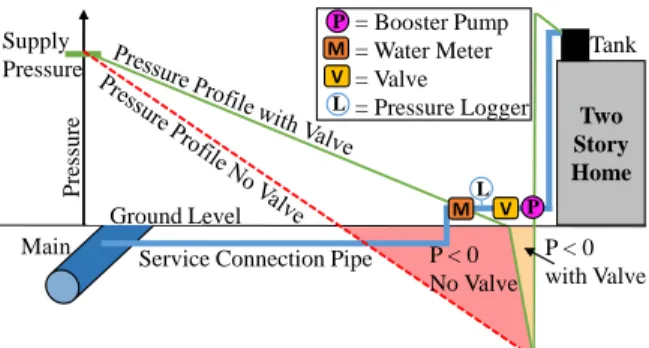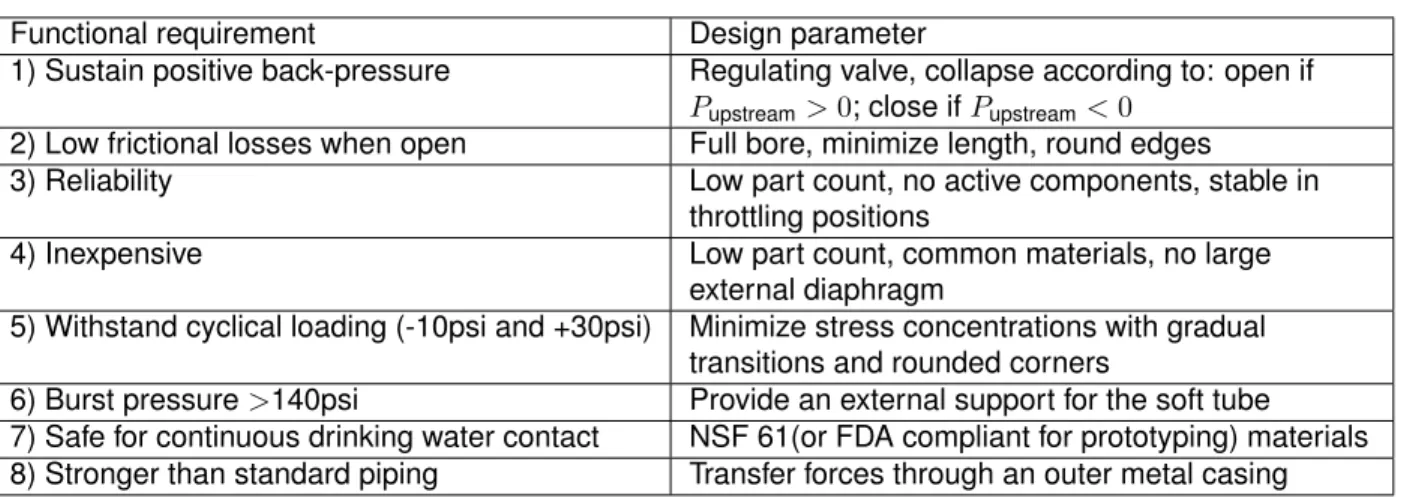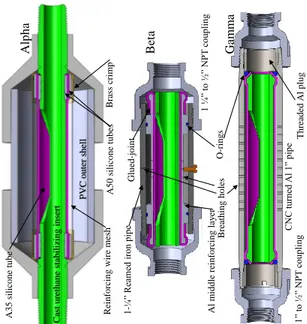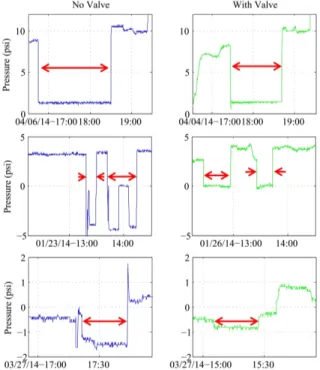Design and testing of a back-pressure regulating valve
to reduce the water contamination risk in New Delhi
The MIT Faculty has made this article openly available.
Please share
how this access benefits you. Your story matters.
Citation
Taylor, David D. J., Alexander H. Slocum and Nevan C. Hanumara.
"Design and testing of a back-pressure regulating valve to reduce
the water contamination risk in New Delhi." Proceedings of the 29th
Annual Meeting of the ASPE, Boston, Massachusetts, Nov 9-14,
2014.
As Published
http://aspe.net/publications/annual_2014/2014%20ASPE
%20Proceedings.pdf
Publisher
American Society for Precision Engineering
Version
Author's final manuscript
Citable link
http://hdl.handle.net/1721.1/118654
Terms of Use
Creative Commons Attribution-Noncommercial-Share Alike
DESIGN AND TESTING OF A BACK-PRESSURE REGULATING VALVE
TO REDUCE THE WATER CONTAMINATION RISK IN NEW DELHI
David D. J. Taylor
1, Alexander H. Slocum
1, and Nevan C. Hanumara
11
Department of Mechanical Engineering
Massachusetts Institute of Technology
Cambridge, Massachusetts, USA
PROBLEM: NEGATIVE SUPPLY PRESSURE
Although 3.7 billion people worldwide have ac-cess to piped water on their premises, there are still significant quantity and quality concerns with their water [1]. Piped water systems in poorer regions of the world often operate intermittently. The Asian Development Bank’s study of 20 major cities in India found that they supplied water for an average of only 4.3 hours per day [2]. Whenever a water pipe is not positively pressured, contam-inants can infiltrate through the holes and cracks in the pipe network and create significant quality concerns [3, 4]. As part of the MIT-Tata Center for Technology and Design the authors worked in col-laboration with New Delhi’s water utility and other private water suppliers to define and address this problem.
When such intermittently-pressurized systems are pressurized, consumers withdraw water as rapidly as possible. High flow rates increase frictional losses and decrease the system pres-sure. Lower system pressure means that water can no longer reach the rooftop storage tanks that many consumers use. To address this low-pressure, many consumers connect half- or one-horsepower booster pumps directly to their water supply pipe. When switched on, these booster pumps can create a suction pressure of up to eight psi.
This suction pressure creates two harmful effects. First, where the water utility’s supply pressure is less than eight psi, it can induce negative pres-sure in the last and smallest pipe leading to the house as shown in Figure 1. Negative pressure can allow contaminants to infiltrate into this sup-ply pipe, which water-supsup-ply engineers in New Delhi cite as the most frequent location for con-tamination to occur. Second, when one house uses a booster pump, the local pressure is re-duced, which causes a reduction in the flow to neighbors’ houses. This in turn forces neighbors to install booster pumps and further exacerbates the booster pump problem.
Two Story Home M Pres su re
Service Connection Pipe Main Supply Pressure Tank P < 0 with Valve V L = Booster Pump = Water Meter = Valve = Pressure Logger M V L P P < 0 No Valve Ground Level P
FIGURE 1. The pressure history at a typical house connection is shown both with (green) and without (red dashed) the valve installed.
SOLUTION: BACK-PRESSURE REGULATOR
One component of the negative pressure problem is booster-pump induced. This component could be mitigated with the use of a back-pressure reg-ulating valve as in Figure 1. As the valve throttled the flow, negative pressure between the valve and the booster pump would increase, leading to cav-itation in the pump. This in turn would force the pump to operate on a modified pump curve, en-forcing a slower flow rate, reducing upstream fric-tional losses, and therefore maintaining positive upstream pressure.
Unfortunately, existing back-pressure regulators either have high frictional losses or are built for large diameter pipes and use large and expen-sive diaphragm actuators. In response to these limitations and with input from water system engi-neers, consultants, and customers in New Delhi, Bangalore, and Mumbai, the functional require-ments outlined in Table 1 were determined.
KEY DESIGN FEATURE: STABILIZED STAR-LING RESISTOR
The key design feature of the self-actuating, full-bore, back-pressure regulating valve is a stabi-lized collapsing tube. The use of a collapsing tube as a regulator is frequently referred to as a “Star-ling Resistor” [5] after E.H. Star“Star-ling, who used one in his experimental apparatus, where the tube only allowed flow through it when the upstream
TABLE 1. Summary of the functional requirements and the design parameters of the valve.
Functional requirement Design parameter
1) Sustain positive back-pressure Regulating valve, collapse according to: open if
Pupstream> 0; close if Pupstream< 0
2) Low frictional losses when open Full bore, minimize length, round edges
3) Reliability Low part count, no active components, stable in throttling positions
4) Inexpensive Low part count, common materials, no large external diaphragm
5) Withstand cyclical loading (-10psi and +30psi) Minimize stress concentrations with gradual transitions and rounded corners
6) Burst pressure >140psi Provide an external support for the soft tube 7) Safe for continuous drinking water contact NSF 61(or FDA compliant for prototyping) materials 8) Stronger than standard piping Transfer forces through an outer metal casing
pressure was greater than or equal to the pres-sure on its outside [6]. The outside prespres-sure in this case is atmospheric pressure and therefore a collapsing tube would prevent negative pressure from passing upstream and would meet functional requirements 1, 2, and 4 in Table 1.
Unfortunately, such resistors are known to have an unstable regime in which they open and close rapidly [7]. Left unchecked, this behavior would induce frequent and severe pressure transients into the water system and accelerate the cyclic fatigue in the collapsing tube. No information was found in the literature about methods or mecha-nisms, theoretical or practical, for removing this instability. Bench-top experimentation, however, showed that the instability could be eliminated by the use of a stabilizing insert inside the collapsing tube.
Four different cross-sectional sizes were exper-imentally investigated (not detailed here, but in Taylor’s thesis [8]). The design which mini-mized the instability, while still effectively regu-lating pressure was a cutaway pipe with a cross-section whose perimeter matched exactly the in-ner circumference of the collapsing tube; the cross-section is shown in Figure 2. With the col-lapsing dynamics stabilized, the valve met the first four functional requirement in Table 1.
DESIGN EVOLUTION
Three iterations of prototypes have attempted to render the collapsing tube concept into a field-testable prototype and are pictured in Figure 3. The alpha prototype featured a cast urethane (green) inner stabilizing layer with a half-inch
in-FIGURE 2. Left: Cross-section of the optimal sta-bilizing insert: a cutaway pipe where the cross-sectional perimeter (green) matches the inner cir-cumference of the collapsing tube. Right: the collapsed section of the tube is concentrated to-wards the downstream end of the stabilizing in-sert and adopts the profile of the inin-sert.
ner diameter. The collapsing tube (pink) was made of Shore A35 silicone rubber and was one-sixteenth of an inch thick. The collapsing tube was reinforced with a wire mesh tube on its out-side to prevent it from ballooning at high pres-sure. Strain-transition layers, also of silicone rub-ber, of A50 were used to improve the fatigue life of the prototype. A brass crimp compressed each of the following to the stabilizing insert: the wire mesh, both transition layers, and the collapsi-ble tube. The entire assembly was then put in-side a two-inch PVC pipe assembly to discourage tampering. During field testing, ‘eager’ plumbers sheared the threads off five of the nine alpha prototypes. Thus, functional requirement 8 was added.
The beta prototype transferred the load through its outer metal layer made of 1.25-inch pipe. A middle reinforcing layer performed three func-tions: it sealed to the outer layer with two O-ring seals, it prevented the collapsing tube’s
balloon-Alph a Beta Gam m a C ast ure thane stabili zing inser t P VC outer she ll 1 -¼” R ea med iron pipe R einfor cing wire mesh A35 sil icone tube B ra ss crimp A50 sil icone tubes Al mi ddle re infor cing lay er 1 ¼” to ½” NPT c oupli ng Glue d -joi nt B re athi ng holes O -ring s C NC turne d Al 1” pipe Thr ea de d Al plug 1” to ½” NPT c oupli ng
FIGURE 3. The design’s evolution is shown from left to right with the alpha, beta, and gamma pro-totypes. Approximate scale 1:3.
ing, and it sealed to the collapsing tube through a glued joint (located on the outside of the middle layer to reduce the joint’s loading). The stabilizing insert was held in place through friction. Although seven beta prototypes were successfully used in a second round of field trials in New Delhi without any instances of failure, the interface between the middle layer and the collapsing tube had a high contact area and the tube did not collapse as eas-ily as in the case of the alpha prototype. Further, stakeholders in India from four private and public water utilities, customers in three neighborhoods, and the World Bank warned that the beta proto-type was too heavy and therefore was likely to be stolen for its recycling value.
The gamma prototype addressed the additional concerns and is also pictured in Figure 3. Threaded plugs screw axially into the valve to compress the blue O-rings to form a seal between the collapsible tube and the outer metal 1-inch pipe. These seals also act to axially anchor the collapsible tube to the inner cast-urethane insert, eliminating the glued joint.
DESIGN VALIDATION: FIELD TESTS IN DELHI
Nine alpha and seven beta prototypes were tested in New Delhi, India in January and March of 2014. The most dramatic example of the valve’s reduction of negative pressure is shown in Figure 4. To evaluate the performance more quantitatively, a cross-over study was conducted
03/31/1404/01 04/02 04/03 04/04 04/05 04/06 04/07 04/08 04/09−10 −5 0 5 10 15 Date Pressure (psi) Pressure History No Valve Valve
FIGURE 4. The effect of the valve at this house was to lower the duration of negative pressure by an average of 5.8 hours per day.
at 19 houses, 12 of which received 24 hours per day of water supply (unexpected by the authors). The performance was measured by the reduction in the duration of negative pressure at the con-nection and by a new metric for contamination risk derived in detail in Taylor’s thesis [8].
The valve proved most effective at the 12 continuously-supplied connections, preventing an average of 82 minutes per day, per house of neg-ative pressure. The valve also reduced the con-tamination risk at each of these connections by a median of 97% — enough to cause significant improvements in the contamination-associated health risks. The pressure regulating function of the valve was evident when pump cycles at the same houses were compared with and without the valve as in Figure 5. The valve made the most significant impact at houses with a connec-tion pressure between three and eight psi.
The results from intermittently-supplied connec-tions were much less clear because: four of the seven intermittently-supplied connections in the study had less than 10 minutes per day of booster-pump-induced negative pressure; the booster-pump-induced risk at the remaining three connections was still only a small fraction of the total risk; and high variability in the pressure his-tory of these connections obscured the effects of the valve. Therefore, these seven connections had a low signal-to-noise ratio, and most conclu-sions about the efficacy of the valve needed to be qualified by ‘while the system was pressurized’ to exclude the large noise effect of the many hours per day of unpressurized pipes.
Combining the results from continuously- and intermittently-supplied connections showed that:
FIGURE 5. The valve’s regulation effect at three houses with different supply pressures. Red ar-rows indicate when the pump was on. In the top two panels, there was no negative pressure to prevent; in the middle two, the valve effectively prevented negative pressure; and in the bottom two, the valve could not prevent all negative pres-sure because the supply prespres-sure was negative.
• without the valve and while the system was pressurized, the contamination risk posed by booster-pump-induced negative pressure was verified as significant;
• the valve was most effective at limiting nega-tive pressure below -1.4psi, preventing 96% of all pressure less than -1.4 psi;
• the valve reduced the duration of negative pressure from an average of 99 to 45 minutes per day, per connection while the system was pressurized;
• the valve reduced the risk of contamination by a median of 80% while the system was pressurized; and
• the valve reduced the contamination risk posed by negative pressure by two orders of magnitude at six houses — enough to cor-respond to significant reductions in health risks.
ACKNOWLEDGMENTS
This work was funded by the generous support of the MIT-Tata Center for Technology and De-sign; the field work was supplemented by the sup-port of the Sir Dorabji Tata Trust. Field assistance was received from the Delhi Jal Board and private bodies involved in the management and operation of New Delhi’s water system. Their support was generous and is appreciated greatly.
REFERENCES
[1] UNICEF, World Health Organization. Progress on drinking water and sanitation. 2012th ed. Geneva; New York: World Health Organization & Unicef; 2012.
[2] Asian Development Bank, Ministry of Urban Development Government of India. Bench-marking and data book of water utilities in In-dia. Manila: Asian Development Bank; 2007. [3] Lindley TR, Buchberger SG. Assessing in-trusion susceptibility in distribution systems. Journal of American Water Works Associa-tion. 2002 Jun;94(6):66.
[4] Kumpel E, Nelson KL. Comparing microbial water quality in an intermittent and contin-uous piped water supply. Water Research. 2013 Sep;47(14):5176–5188.
[5] Conrad WA. Pressure-flow relationships in collapsible tubes. IEEE Transactions on Biomedical Engineering. 1969 Oct;BME-16(4):284–295.
[6] Knowlton FP, Starling EH. The influence of variations in temperature and blood-pressure on the performance of the isolated mammalian heart. The Journal of Physiol-ogy. 1912 May;44(3):206–219.
[7] Bertram CD, Tscherry J. The onset of flow-rate limitation and flow-induced oscillations in collapsible tubes. Journal of Fluids and Structures. 2006 Nov;22(8):1029–1045. [8] Taylor DDJ. Reducing
booster-pump-induced contaminant intrusion in Indian wa-ter systems with a self-actuated, back-pressure regulating valve [Thesis]. Mas-sachusetts Institute of Technology. Cam-bridge, MA; 2014.



